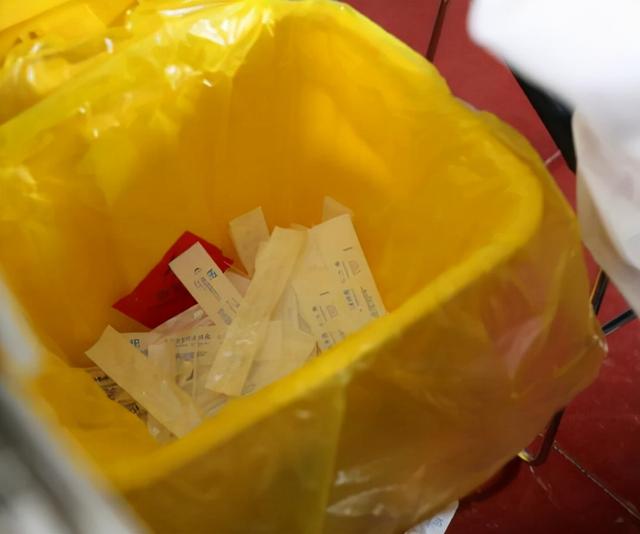ในโรงพยาบาล, ไม้กวาด เป็นเครื่องมือสำคัญในการเก็บตัวอย่าง, การควบคุมการติดเชื้อ, และการทดสอบวินิจฉัย. อย่างไรก็ตาม, การจัดการขยะจากไม้กวาดเป็นปัญหาที่ซับซ้อนที่สถานพยาบาลต้องจัดการเพื่อให้เกิดความยั่งยืนด้านสิ่งแวดล้อมและความปลอดภัยของผู้ป่วย. การกำจัดผ้าเช็ดทำความสะอาดและของเสียทางการแพทย์อื่นๆ ได้รับการควบคุมโดยแนวทางที่เข้มงวดเพื่อลดการปนเปื้อนและป้องกันการแพร่กระจายของการติดเชื้อ. ภาพรวมของวิธีที่โรงพยาบาลจัดการขยะจากไม้กวาดมีดังนี้:

ความสำคัญของการกำจัดไม้กวาดอย่างเหมาะสม
ไม้กวาด, รวมถึงสำลี, ก้านโฟม, และผ้าพันสำลี, ใช้ในกระบวนการทางการแพทย์ที่หลากหลาย. หลังการใช้งาน, มักปนเปื้อนของเหลวในร่างกาย, เชื้อโรค, หรือสารเคมี. การกำจัดขยะจากไม้กวาดอย่างไม่เหมาะสมอาจนำไปสู่การปนเปื้อนข้ามได้, การแพร่กระจายของการติดเชื้อ, และอันตรายต่อสิ่งแวดล้อม. โรงพยาบาลต้องปฏิบัติตามแนวทางที่กำหนดโดยหน่วยงานด้านสุขภาพและหน่วยงานคุ้มครองสิ่งแวดล้อมเพื่อให้มั่นใจถึงการจัดการที่ปลอดภัย, การกำจัด, และการรีไซเคิลวัสดุเหล่านี้.
ขั้นตอน 1: การแบ่งประเภทขยะทางการแพทย์
ขั้นตอนแรกๆ ที่โรงพยาบาลดำเนินการในการจัดการขยะจากไม้กวาดคือการจำแนกประเภทขยะอย่างถูกต้อง. ขยะจากไม้กวาดจัดอยู่ในประเภทของ “ของเสียทางการแพทย์ที่ได้รับการควบคุม” (RMW) เนื่องจากมีโอกาสติดเชื้อได้. โดยทั่วไปขยะทางการแพทย์จะแบ่งออกเป็นประเภทต่างๆ ดังต่อไปนี้:
- ขยะติดเชื้อ: รวมถึงไม้กวาดที่ใช้เก็บตัวอย่างหรือดูแลบาดแผลและปนเปื้อนของเหลวหรือเชื้อโรคในร่างกาย.
- ของเสียมีคม: แม้ว่าก้านสำลีจะไม่แหลมก็ตาม, อาจปนเปื้อนด้วยเข็มหรือของมีคมอื่นๆ และกำจัดทิ้งตามนั้น.
- ขยะไม่ติดเชื้อ: ไม้กวาดบางชนิดอาจมีการปนเปื้อนด้วยสารที่ไม่ติดเชื้อและจัดอยู่ในประเภทไม่เป็นอันตราย.
โดยแยกประเภทขยะให้เหมาะสม, โรงพยาบาลดูแลให้มีการกำจัดของเสียแต่ละประเภทอย่างเหมาะสม.
ขั้นตอน 2: การกำจัดและการแยกอย่างปลอดภัย
เมื่อรวบรวมขยะจากไม้กวาดแล้ว, มันถูกแยกออกเป็นรหัสสี, ภาชนะป้องกันการรั่วที่เป็นไปตามข้อกำหนดด้านกฎระเบียบท้องถิ่นสำหรับขยะทางการแพทย์. ในโรงพยาบาลส่วนใหญ่, ใช้ระบบคัดแยกขยะสามชั้น:
- ถังขยะแดง: สำหรับขยะติดเชื้อ, เช่น ไม้พันสำลีที่ใช้ในการตรวจหาไวรัสหรือการติดเชื้อแบคทีเรีย.
- ถังขยะสีเหลือง: สำหรับของเสียทางการแพทย์ทั่วไปที่อาจไม่ติดเชื้อแต่ยังต้องจัดการด้วยความระมัดระวัง.
- คอนเทนเนอร์ชาร์ป: สำหรับเข็มที่ใช้แล้วและของมีคมที่อาจสัมผัสกับสำลี.
ถังขยะแต่ละใบปิดสนิทเพื่อป้องกันการรั่วซึมและลดความเสี่ยงในการติดเชื้อ. โรงพยาบาลก็ใช้ความเชี่ยวชาญเฉพาะทางเช่นกัน, ถุงอันตรายทางชีวภาพเพื่อบรรจุสำลีที่ใช้แล้วและวัสดุเหลือใช้อื่น ๆ ก่อนที่จะเคลื่อนย้ายไปยังพื้นที่กำจัด.
ขั้นตอน 3: วิธีการรักษาและกำจัด
โดยทั่วไปแล้วของเสียจากไม้กวาดจะถูกฆ่าเชื้อและบำบัดเพื่อให้แน่ใจว่าปราศจากสารติดเชื้อใดๆ. วิธีการบำบัดขยะทางการแพทย์หลักๆ มี 2 วิธีคือ:
- นึ่งฆ่าเชื้อ: วิธีการกำจัดขยะติดเชื้อที่พบบ่อยที่สุด, การนึ่งฆ่าเชื้อโดยใช้ไอน้ำภายใต้ความกดดันเพื่อฆ่าเชื้อของเสีย. ความร้อนสูงช่วยให้แน่ใจว่าเชื้อโรคบนไม้พันจะถูกทำลายก่อนที่จะส่งไปกำจัดขั้นสุดท้าย.
- การเผา: ในบางกรณี, ของเสียทางการแพทย์จะถูกเผาที่อุณหภูมิสูงเพื่อให้แน่ใจว่าจุลินทรีย์ที่เป็นอันตรายจะถูกทำลายอย่างสมบูรณ์. วิธีการนี้มีประสิทธิภาพโดยเฉพาะกับของเสียที่ไม่สามารถนึ่งฆ่าเชื้อได้.
หลังการฆ่าเชื้อ, ของเสียที่ผ่านการบำบัดจะถูกส่งไปยังสถานที่ฝังกลบหรือรีไซเคิล, ขึ้นอยู่กับลักษณะของขยะ. โรงพยาบาลเริ่มนำแนวปฏิบัติที่เป็นมิตรต่อสิ่งแวดล้อมมาใช้มากขึ้น, เช่นการลดปริมาณขยะที่ไม่สามารถรีไซเคิลได้ที่เกิดขึ้น, และไม้กวาดบางชนิดสามารถนำกลับมาใช้ใหม่ได้หลังการฆ่าเชื้อ.
ขั้นตอน 4: การรีไซเคิลและความยั่งยืน
ในปีที่ผ่านมา, โรงพยาบาลหลายแห่งหันมาใช้หลักปฏิบัติในการจัดการขยะอย่างยั่งยืนมากขึ้น, รวมถึงการรีไซเคิลและแปรรูปอุปกรณ์ทางการแพทย์บางรายการ. ในขณะที่การรีไซเคิลไม้กวาดด้วยตนเองอาจไม่สามารถทำได้เนื่องจากการปนเปื้อน, วัสดุบางอย่างที่เกี่ยวข้องกับขยะจากไม้กวาด, เช่นบรรจุภัณฑ์และส่วนประกอบพลาสติก, สามารถรีไซเคิลได้. โรงพยาบาลกำลังลงทุนในเทคโนโลยีการเปลี่ยนขยะเป็นพลังงานและทางเลือกในการกำจัดอย่างยั่งยืนเพื่อลดผลกระทบต่อสิ่งแวดล้อม.
นอกจากนี้, ผู้ผลิตทางการแพทย์ กำลังผลิตผ้าเช็ดทำความสะอาดและวัสดุสิ้นเปลืองอื่นๆ ที่ทำจากวัสดุที่ย่อยสลายได้ทางชีวภาพหรือเป็นมิตรกับสิ่งแวดล้อม เพื่อลดปริมาณของเสียที่ไม่สามารถรีไซเคิลได้ที่เกิดขึ้น. โรงพยาบาลยังสามารถลดผลกระทบต่อสิ่งแวดล้อมได้ด้วยการเพิ่มประสิทธิภาพการจัดการสินค้าคงคลัง และลดการใช้ผ้าเช็ดทำความสะอาดแบบใช้ครั้งเดียวโดยไม่จำเป็น.
ขั้นตอน 5: การฝึกอบรมพนักงานและการปฏิบัติตามกฎระเบียบ
การจัดการขยะอย่างมีประสิทธิผลเริ่มต้นจากบุคลากรทางการแพทย์ที่ได้รับการฝึกอบรมมาเป็นอย่างดี. โรงพยาบาลจัดให้มีการฝึกอบรมสำหรับบุคลากรทุกคนที่เกี่ยวข้องกับการจัดการและกำจัดขยะทางการแพทย์, สร้างความมั่นใจว่าพวกเขาเข้าใจถึงความสำคัญของระเบียบการด้านความปลอดภัยและการแยกขยะอย่างเหมาะสม. โรงพยาบาลยังปฏิบัติตามข้อกำหนดของท้องถิ่น, สถานะ, และกฎระเบียบระดับชาติเพื่อลดความเสี่ยงของการสัมผัสกับโรคติดเชื้อและการปนเปื้อนในสิ่งแวดล้อม.
บทสรุป
โรงพยาบาลต้องจัดการขยะจากไม้กวาดอย่างระมัดระวังเพื่อปกป้องทั้งสุขภาพของประชาชนและสิ่งแวดล้อม. โดยปฏิบัติตามระเบียบการที่เข้มงวดในการจัดหมวดหมู่, การกำจัดของ, และการบำบัดของเสียทางการแพทย์, สถานพยาบาลลดความเสี่ยงที่เกี่ยวข้องกับการกำจัดไม้กวาด. ในขณะที่โรงพยาบาลยังคงเปิดรับความยั่งยืน, แนวปฏิบัติในการจัดการขยะจะมีการพัฒนาเพื่อตอบสนองทั้งความต้องการด้านการดูแลสุขภาพและเป้าหมายด้านสิ่งแวดล้อม.

















